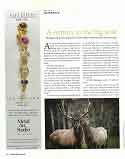A Century in the Big Wild

By Dianna Stampfler
A veil of fog rises above amber-colored fields on a chilly fall morning in the Pigeon River Country State Forest 20 miles north of Gaylord. Beams of sun cut through the towering trees, casting dancing shadows below. In the distance, a distinctive bugling sound permeates the air, first from one direction and then another.
The elk rut has begun.
In September and October, bulls and cows engage in their annual mating rituals. This draws countless tourists who trek down dirt roads and winding two-tracks to one of the dozen designated viewing areas just to get a glimpse of these massive creatures in their natural habitat.
The population of Michigan’s second-largest mammal—weighing as much as nine hundred pounds each—is near a record high, with an estimated 854 to 1,512 head within this 106,000-acre tract referred to as “The Big Wild.” This is the one of only two free-ranging elk herd in the Midwest and is either the second or third largest this side of the Mississippi (often changing ranking with Pennsylvania), housed on the largest tract of wild land in the northern Lower Peninsula.
Impressive considering that by the turn of the twentieth century, native elk had all but disappeared from this northern landscape due to over-harvesting and lack of management. There were no licenses, designated hunting seasons or limits on how many elk could be harvested. At the same time, large sections of land were being cleared for the development of communities, timber was logged and shipped throughout the Great Lakes to cities like Chicago and the elk’s habitat was slowly eliminated.
By 1908, Michigan’s native elk were extinct.
Yet, within ten years, efforts were underway to reintroduce the species back into the region. In 1918, seven Rocky Mountain elk (two bulls and five cows) were brought in from Yellowstone National Park in Wyoming and released in southern Cheboygan County near the Sturgeon River, between Wolverine and Vanderbilt. The area was cut over, burnt over and wide open, while also providing good thermal cover, making it a prime environment for the new herd to thrive.
This year, conservationists, nature lovers and tourism leaders celebrate the 100th anniversary of the monumental act that brought elk back to Michigan. A poster contest was held, the state’s wildlife license plate was redesigned to feature a bull elk and a new Discovery Center was opened to display historical artifacts for the region.
“This really is a wonderful conservation success story,” says Brian Mastenbrook, Wildlife Field Operations Manager for the Michigan Department of Natural Resources. “What we’re doing is for us but also future generations. I want people to value our wildlife and when they’re here to look out and think their life is better because of all this.”
For information on the elk viewing areas within the Pigeon River Country State Forest, visit Mi.gov/elk or GaylordMichigan.net.
SIDEBAR:
The new Pigeon River Country Discovery Center opened on Memorial Day weekend and is located on Twin Lakes Road, behind the forest headquarters. According to Sandy Franz, this seven-room historic log cabin—built in the mid-1930s by the Civilian Conservation Corps—features “original documents and photographs, quotations and recorded interviews which educate visitors about the forest’s history, the people who loved it, the controversies that shaped it and its many recreational offerings.” The center is open Saturdays, Sundays and holidays, from spring through fall, from 10 a.m. until 4 p.m. Admission is free, but donations are welcome. For more information, visit PigeonRiverDiscoveryCenter.org.
SIDEBAR #2
A new wildlife license plate featuring an elk was introduced by the Department of Transportation last December, with $10 from the sale of each plate going toward wildlife habitat work in the state. For more information, visit Michigan.gov/SOS.
